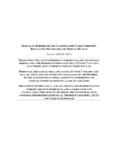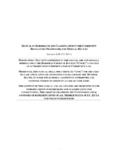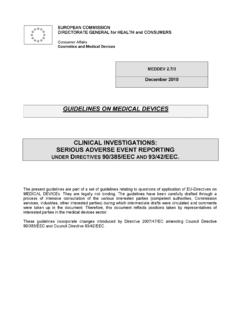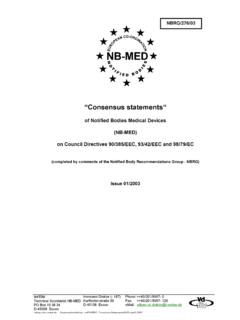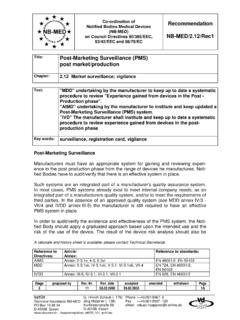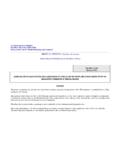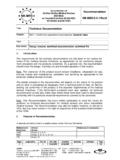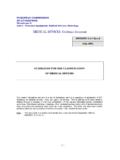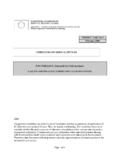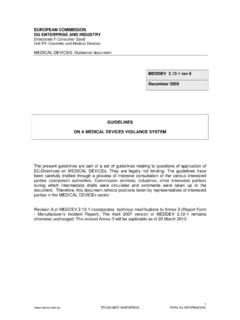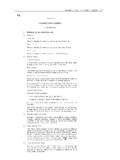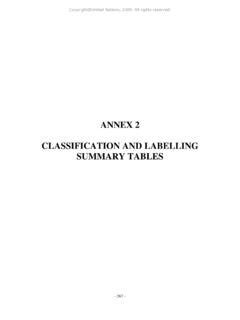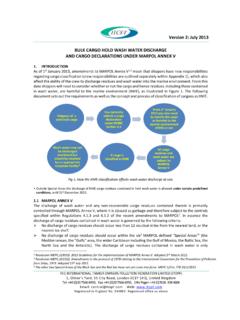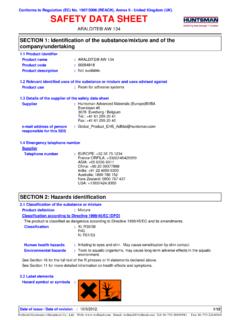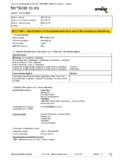Transcription of MEDICAL DEVICES Guidance document Classification of ...
1 1 EUROPEAN COMMISSION DG HEALTH AND CONSUMER Directorate B, Unit B2 Cosmetics and MEDICAL DEVICES MEDICAL DEVICES : Guidance document - Classification of MEDICAL DEVICES MEDDEV 2. 4/1 Rev. 9 June 2010 GUIDELINES RELATING TO THE APPLICATION OF THE COUNCIL DIRECTIVE 93/42/EEC ON MEDICAL DEVICES Foreword The present MEDDEV is part of a set of guidelines relating to questions of application of EU Directives on MEDICAL DEVICES . They are not legally binding. Only the European Court of Justice can give an authoritative interpretation of Community Law. This MEDDEV contains Guidance for the application of the Classification rules for MEDICAL DEVICES as set out in Annex IX of Directive 93/42/EEC1, as amended. It is for the national Competent Authorities and national Courts to take legally binding decisions on a case-by-case basis. Directive 93/42/EEC, as amended, allows for derogation from the Classification rules outlined in its Annex IX in light of technical progress or on information gathered from post-market experience with the device.
2 1 OJ L 169, , p. 1 2 This MEDDEV has been revised after consultation with various interested parties ( Competent Authorities, Commission services, industry and other stakeholders) and therefore this document reflects a consensus view on the Classification of MEDICAL DEVICES . Active implantable MEDICAL DEVICES and in vitro diagnostic MEDICAL DEVICES are covered by separate Directives, which do not apply the Classification rules reviewed in this MEDDEV. Note: This document is a revision of an earlier document published in July 2001 as MEDDEV rev 8. It includes information pertaining to the changes in Classification resulting from the amending and implementing Directives issued since the last revision of this document in 2001, including derogation of the Classification rules in the case of breast implants and hip, knee and shoulder joint replacements and requirements related to DEVICES containing human blood derivatives and MEDICAL DEVICES manufactured utilising tissues of animal origin.
3 In addition this Guidance document takes account of the changes arising from Directive 2007/47/EC2 which further amends Directive 93/42/EEC and became applicable as from 21st March 2010. 2 OJ L 247, , p. 21 3 CONTENTS Pages 1. PURPOSE AND PHILOSOPHY OF MEDICAL DEVICE Classification 2. PRACTICAL RELEVANCE OF Classification General requirements Conformity assessment Clinical evaluation and investigation Instructions for use Miscellaneous 3. HOW TO CARRY OUT Classification Basic definitions Application of the Classification rules How to use the rules Practical example Handling of interpretational problems 4. EXPLANATIONS OF INDIVIDUAL RULES Graphical summary - Guidance chart General explanation of rules/practical issues/examples 41. PURPOSE AND PHILOSOPHY OF MEDICAL DEVICE Classification It is not feasible economically nor justifiable in practice to subject all MEDICAL DEVICES to the most rigorous conformity assessment procedures available.
4 A graduated system of control is more appropriate. In such a system, the level of control corresponds to the level of potential hazard inherent in the type of device concerned. A MEDICAL device Classification system is therefore needed, in order to apply to MEDICAL DEVICES an appropriate conformity assessment procedure. In order to ensure that conformity assessment under the MEDICAL Device Directive functions effectively, manufacturers should be able to determine the Classification of their product as early as possible in device development. It was therefore decided to set up a system of Classification rules within the Directive, so that each manufacturer could classify its own DEVICES . The Classification of MEDICAL DEVICES is a risk based system based on the vulnerability of the human body taking account of the potential risks associated with the DEVICES .
5 This approach allows the use of a set of criteria that can be combined in various ways in order to determine Classification , duration of contact with the body, degree of invasiveness and local vs. systemic effect. These criteria can then be applied to a vast range of different MEDICAL DEVICES and technologies. These are referred to as the Classification rules and are set out in Annex IX of Directive 93/42/EEC. They correspond, to a large extent, to the Classification rules established by the Global Harmonization Task Force (GHTF) in the Guidance document GHTF/SG1/N15:20063. It is recognized that although the existing rules will adequately classify the vast majority of existing DEVICES , a small number of products may be more difficult to classify. Such cases may in particular include DEVICES which are borderline cases between two different classes of MEDICAL DEVICES .
6 In addition there may be DEVICES that cannot be classified by the existing rules because of their unusual nature or situations where the Classification would result in the wrong level of conformity assessment in light of the hazard represented by the device (see also section ). 2. PRACTICAL RELEVANCE OF Classification General requirements Irrespective of the class of the device, all DEVICES must: - meet the essential requirements, including the requirements regarding the information to be supplied by the manufacturer (Annex I of the Directive 93/42/EEC); - be subject to the reporting requirements under the MEDICAL device vigilance system; 3 5- be CE marked (except custom-made DEVICES and DEVICES intended for clinical investigation, in which case they should comply with the provisions of Annex VIII of Directive 93/42/EEC regarding the statement on DEVICES for special purposes.)
7 Conformity Assessment Conformity assessment is the method by which a manufacturer demonstrates that their DEVICES comply with the requirements of Directive 93/42/EEC. The Classification of the MEDICAL device will have an impact on the conformity assessment route that the manufacturer should follow in order to affix the CE marking on the MEDICAL device. CONFORMITY ASSESSMENT PROCEDURES CLASSES ANNEXES I I Sterile I measure IIa IIb III II (+ section 4) II (- section 4) III IV V VI VII Technical documentation relating to products in class IIa and class IIb must be reviewed by a notified body of the basis of a programme of representative sampling in the context of Annexes II, V and VI of Directive 93/42/EEC.
8 Clinical evaluation and investigation As part of the Essential Requirements, a clinical evaluation in accordance with Annex X must be conducted for all MEDICAL DEVICES . (Annex I part I, 6a of Directive 93/42/EEC). 6 The MEDICAL DEVICES Directive states in Annex X that as a general rule confirmation of conformity with the requirements concerning the characteristics and performances referred to in sections 1 and 3 of Annex I of Directive 93/42/EEC under the normal conditions of use of the device and the evaluation of the undesirable side-effects must be based on clinical data. In addition, according to Annex X Section of Directive 93/42/EEC in the case of implantable DEVICES and DEVICES in class III clinical investigations shall be performed unless it is duly justified to rely on existing clinical data.
9 For further Guidance on clinical evaluation see MEDDEV Pursuant to article , in case of DEVICES intended for clinical investigations, the manufacturer shall notify the Competent Authorities of the Member States in which the investigations are to be conducted in accordance with section of Annex VIII. Clinical investigations with Class III DEVICES and implantable and long-term invasive DEVICES falling within Class IIa or IIb may start 60 days after the manufacturer's notification to the Competent Authority unless the Competent Authority has notified a decision to the contrary based on considerations of public health or public policy within this timeframe (article ). For further details see article15 of Directive 93/42/EEC. Instructions for use Instructions for use are not required for Class I and IIa DEVICES if these DEVICES can be used safely without any such instructions (Annex I Section of Directive 93/42/EEC).
10 Miscellaneous The manufacturer of a Class I MEDICAL device, or his relevant authorised representative in the European Union designated by him, must notify their address and a description of the DEVICES concerned to the Competent Authority of the Member State where they have their registered place of business (Article 14, paragraphs 1 and 2 of Directive 93/42/EEC). For MEDICAL DEVICES of classes IIa, IIb and III, Member States may request to be informed of all data allowing for identification of such DEVICES together with the label and the instructions for use when such DEVICES are put into service within their territory (second sub-paragraph of Article 14, paragraph 1, of Directive 93/42/EEC). 3. HOW TO CARRY OUT Classification 4 7 The manufacturer should first decide if the product concerned is a MEDICAL device as defined in Directive 93/42/EEC or an accessory to such a MEDICAL device, if it is not excluded from the scope of this Directive and if it therefore comes within the scope of this Directive.
